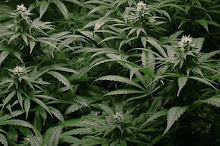A scientist with a rough past explains how he used his life experiences to blow the lid off modern drug research.
June 19, 2013 |
This is the prologue to Columbia University researcher Dr. Carl Hart's explosive new book, " High Price: A Neuroscientist's Journal of Self-Discovery That Challenges Everything You Know About Drugs and Psychology." Read a Q&A with the author here.
The paradox of education is precisely this—that as one begins to become conscious, one begins to examine the society in which he is being educated.
—James Baldwin
The straight glass pipe filled with ethereal white smoke. It was thick enough to see that it could be a good hit, but it still had the wispy quality that distinguishes crack cocaine smoke from cigarette or marijuana smoke. The smoker was thirty-nine, a black man, who worked as a street bookseller. He closed his eyes and lay back in the battered leather office chair, holding his breath to keep the drug in his lungs as long as possible. Eventually, he exhaled, a serene smile on his face, his eyes closed to savor the bliss.
About fifteen minutes later, the computer signaled that another hit was available.
“No, thanks, doc,” he said, raising his left hand slightly. He hit the space bar on the Mac in the way that he’d been trained to press to signal his choice.
Although I couldn’t know for sure whether he was getting cocaine or placebo, I knew the experiment was going well. Here was a middle-aged brother, someone most people would label a “crackhead,” a guy who smoked rock at least four to five times a week, just saying no to a legal hit of what had a good chance of being 100 percent pure pharmaceutical-grade cocaine. In the movie version, he would have been demanding more within seconds of his first hit, bug-eyed and threatening—or pleading and desperate.
Nonetheless, he’d just calmly turned it down because he preferred to receive five dollars in cash instead. He’d sampled the dose of cocaine earlier in the session: he knew what he would get for his money. At five dollars for what I later learned was a low dose of real crack cocaine, he preferred the cash.
Meanwhile, there I was, another black man, raised in one of the roughest neighborhoods of Miami, who might just as easily have wound up selling cocaine on the street. Instead, I was wearing a white lab coat and being funded by grants from the federal government to provide cocaine as part of my research into understanding the real effects of drugs on behavior and physiology. The year was 1999.
In this particular experiment, I was trying to understand how crack cocaine users would respond when presented with a choice between the drug and an “alternative reinforcer”—or another type of reward, in this case, cash money. Would anything else seem valuable to them? In a calm, laboratory setting, where the participants lived in a locked ward and had a chance to earn more than they usually could on the street, would they take every dose of crack, even small ones, or would they be selective about getting high? Would merchandise vouchers be as effective as cash in altering their behavior? What would affect their choices?
Before I’d become a researcher, these weren’t even questions that I would think to ask. These were drug addicts, I would have said. No matter what, they’d do anything to get to take as much drugs as often as possible. I thought of them in the disparaging ways I’d seen them depicted in films like New Jack City and Jungle Fever and in songs like Public Enemy’s “Night of the Living Baseheads.” I’d seen some of my cousins become shells of their former selves and had blamed crack cocaine. Back then I believed that drug users could never make rational choices, especially about their drug use, because their brains had been altered or damaged by drugs.
Pages
- 1
- 2
- 3
- 4
- Next page »





No comments:
Post a Comment